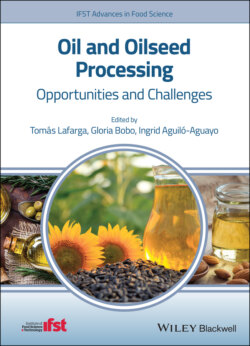Читать книгу Oil and Oilseed Processing - Ingrid Aguilo-Aguayo - Страница 25
1.2.11 Sunflower
ОглавлениеThe common name sunflower refers to the popular annual species Helianthus annuus L., grown as food crops for humans, cattle, and poultry or as ornamental plants. The oil content of sunflower seeds is around 50% (w/w) (Salas et al. 2015). Sunflower seeds are crushed for oil recovery via either hard pressing or prepress solvent extraction. The former relies on exerting high pressure on the seeds to separate the oil from the solid fraction obtaining recovery yields close to 25% (Williams 2005). In turn, the latter relies on exerting medium pressure followed by solvent extraction and allows recovering approximately 40% of the seed’s oil (Le Chef and Kemper 2015). Crude sunflower oil contains several impurities which are removed by degumming, to remove phosphatides, chemical neutralization to remove free fatty acids and residual phosphatides, and bleaching, which aims at removing colored compounds such as chlorophylls and carotenes. Other processes which include dewaxing and deodorization generally by stripping under vacuum with steam at elevated temperatures are also applied (Dijkstra 2015).
Figure 1.5 Soybean oil: Production and trade. Abbreviation: US, United States of America.
Source: Data accessed on April 8, 2019 from FAOSTAT, available at http://www.fao.org/faostat.
Sunflower grows better at temperate (20–25 °C) and dry climates with high irradiation and deep soils (Salas et al. 2015). Argentina was the biggest sunflower seed and oil producer until the late twentieth century, when it was surpassed by Ukraine and Russia after important economic and technological reforms (Feoll and Ingaramo 2015). Currently, over 75% of the sunflower oil commercialized worldwide is made in Europe (Figure 1.6). The total area dedicated to cultivate sunflower seeds increased from 3.79 Mha in 2008 to 4.17 Mha in 2018, representing an average 11.3% annual increase (European Commission 2019).
Figure 1.6 Sunflower seed oil: Production and trade.
Source: Data accessed on April 8, 2019 from FAOSTAT, available at http://www.fao.org/faostat.
Despite being a Native American plant, traditionally, the main regions of sunflower oil consumption are the EU and former soviet countries. Ukraine and Russia are currently the largest producers, followed by Argentina. In 2017, Ukraine, Russia, and Argentina produced 12.23, 10.48, and 3.54 Mt, respectively. Expected production gains for Ukraine (to 15.5 in 2018/2019 from 13.7 Mt in 2017/2018) will be caused by improved sunflower yields, as Ukraine's crop area is expected to stay unchanged in 2018/2019 at 6.4 Mha (USDA 2018). In the EU‐28, sunflower seed production increased from 7.21 Mt in 2008 to 10.17 Mt in 2018 (European Commission 2019). World sunflower seed production was 51.49 Mt during 2018/2019 (USDA 2019a). Russia and especially Ukraine are not only the biggest producers but also the biggest sunflower oil exporters. In 2017, Ukraine exported 3.97 Mt of sunflower oil. According to the International Sunflower Oil Association, in 2016, sunflower oil was exported to more than 110 countries in the world. Top importers in 2017 are shown in Figure 1.6 and are led by India and China, which imported approximately 1.52 and 0.96 Mt of sunflower oil in 2017, respectively.
